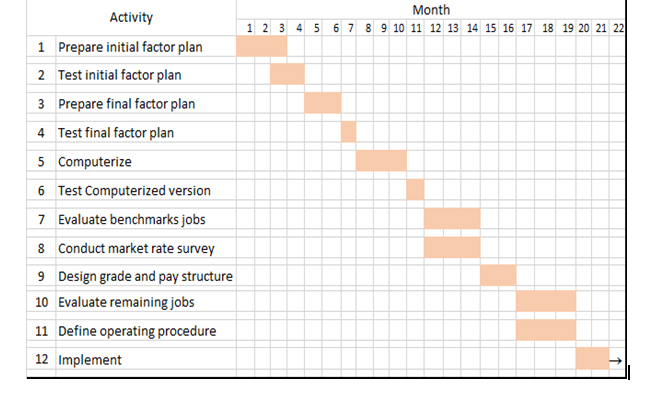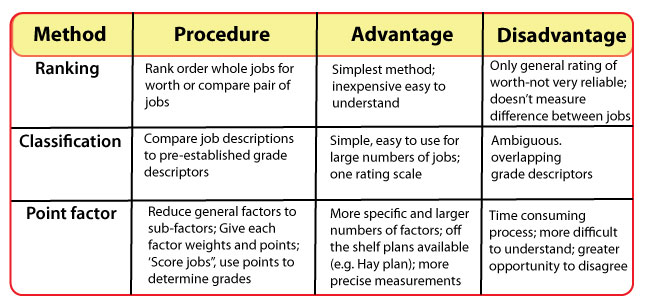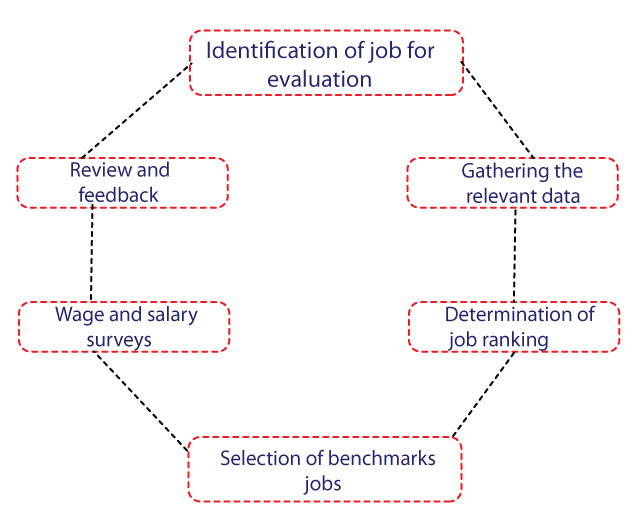Job Evaluation (Human Resource Management)
Job evaluation is the process to assess the relative value of a job in an organisation by comparing it with other jobs within the organisation and with job market outside. It attempts to make a methodical comparison between jobs to assess their relative worth for the purpose of establishing a rational pay structure. Job evaluation is different from job analysis. Job analysis is a systematic way to accumulate information about a job. Every job evaluation method requires some basic job analysis in order to provide accurate information about the jobs concerned. Therefore, job evaluation begins with job analysis and ends at that point where the value of a job is determined for achieving pay equity between jobs. Basically, Job evaluation is the application of a process to identify, analyse and measure each job against established criteria and weigh the relative value of jobs in a uniform and consistent manner. It is not used to obtain a salary increase for the incumbent.
Major objectives of job evaluation is to establish logical & accurate relationship of each job to other jobs within organisation, to regulate the wage rate for each job in relation to other job in the organisation, to select employees accurately and train, promote or transfer them impartially, to encourage employee goodwill, strengthen morale and provide an incentive and to provide management with a basis for proper control.
Jobs are evaluated when a new post is established, prior to recruitment and when an existing position has changed 10-15%
Figure: A typical job evaluation programme
Methods of Job Evaluation
There are many methods by which job evaluation is done.
- Ranking / Grading Method: Under ranking method, jobs are organized in descending order of importance with the help of job description and job specification. The ranking of job is done by a committee of experts called raters. The ranking is done at departmental level, for every department the job is ranked in order of importance. The main benefits of this method are that it is simple, easily understood by all concerned and easy to operate, inexpensive and can be used conveniently in small establishments. The limitations include the degree of differences in the jobs. Sometimes it is based on the rater's general knowledge of the jobs. It is inappropriate for big company with a complex organisational structure.
- Factor Comparison / Weight-in-Money Method: In this type of procedure, the jobs are ranked in the following way: Common key elements of different jobs are selected. These selected key elements are weighted and ranked. A monetary value is assigned to each element of all jobs. Then these monetary values of individual jobs are weighted. Then total value of each job is available. The major benefits if this methods are that it is more accurate and systematic as compared to simple ranking method. Different jobs also can be rated on the basis of common factors. The drawbacks of this method comprise that it is complicated, not easily explainable and expensive. Application of weightage and monetary values may involve bias of rankers. It is difficult to install hence not used extensively.
- . Point Rating Method: In this method, each job is appraised separately, considering each of the job factors such as skill, effort, responsibility and working conditions and combining them into a single point score for each job. Main advantages are that it is analytical in its approach, it gives a quantitative value for each job. Basis and guidelines of valuation are standardized and codified in a user manual. Disadvantages include, manual used for rating the jobs needs periodical revision and update. It is difficult for application and unintelligible for workers.

Computer Assisted Job Evaluation
Computers can be used to assist directly with the job evaluation process.
There are many types of schemes:
There are two types of computer-assisted systems. First, there are job analysis-based schemes such as that offered by Link Consultants in which the job analysis data is either entered direct into the computer or transferred to it from a paper questionnaire. The computer software applies predetermined rules based on an algorithm that reflects the organization's evaluation standards to convert the data into scores for each factor and produce a total score. The algorithm replicates panel judgements both on job factor levels and overall job score.
Secondly, there are interactive schemes using software such as that supplied by Pilat UK (Gauge) in which the job holder and his or her manager sit in front of a PC and are presented with a series of logically interrelated questions forming a question tree. The answers to these questions lead to a score for each of the built-in factors in turn and a total score.
There are numerous benefits of computer-assisted job evaluation. Computer-assisted job evaluation systems can provide for greater consistency. The same input information will always give the same output result because the judgemental framework on which the scheme is based (the algorithm), can be applied consistently to the input data. It offers extensive database capabilities for sorting, analysing and reporting on the input information and system outputs. This method speeds up the job evaluation process once the initial design is complete.
Process of Job Evaluation
The process of job evaluation involves following steps:
Securing acceptance from employees after explaining the purpose and use of job evaluation programme.
Creating job evaluation committee consisting of experienced employees, union representatives and HR experts.
Deciding the job to be evaluated, which may represent the type of work performed in the organisation.
Analysing and preparing job description.
Selecting method of evaluation, according to the job factors and organisational demand.
Classifying the jobs on the basis of weightage and monetary values.
Installing the programme in the whole organisation after explaining it to employees.
Conducting periodical review in the light of changes in environment from time to time.
Job evaluation process
To summarize, Job evaluation is associated with a process of establishing worth of different jobs. Job evaluation offers a basis for ranking or grading different jobs and developing a pay structure for them. It is the process of explaining the duties, authority relationships, skills, condition of work and other relevant information related to jobs. It provides valuable data and information to develop job description and specification documents. Job evaluation is a significant task of human resource manager which is done in order to determine the value or worth of each job within the organization.

